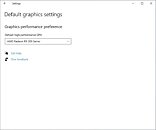Raevenlord
News Editor
- Joined
- Aug 12, 2016
- Messages
- 3,755 (1.18/day)
- Location
- Portugal
| System Name | The Ryzening |
|---|---|
| Processor | AMD Ryzen 9 5900X |
| Motherboard | MSI X570 MAG TOMAHAWK |
| Cooling | Lian Li Galahad 360mm AIO |
| Memory | 32 GB G.Skill Trident Z F4-3733 (4x 8 GB) |
| Video Card(s) | Gigabyte RTX 3070 Ti |
| Storage | Boot: Transcend MTE220S 2TB, Kintson A2000 1TB, Seagate Firewolf Pro 14 TB |
| Display(s) | Acer Nitro VG270UP (1440p 144 Hz IPS) |
| Case | Lian Li O11DX Dynamic White |
| Audio Device(s) | iFi Audio Zen DAC |
| Power Supply | Seasonic Focus+ 750 W |
| Mouse | Cooler Master Masterkeys Lite L |
| Keyboard | Cooler Master Masterkeys Lite L |
| Software | Windows 10 x64 |
Microsoft's future update to Windows 10 will add a GPU-aware selector that allows both the OS and the user to adaptively select the best GPU for each usage scenario. The preview release of Windows 10 build 20190 features this in two ways. First is an OS-level layer that automagically selects the best GPU for the task at hand between installed options (let's assume, an Intel iGPU and your discrete GPU). For web browsing or productivity it's expected the OS will switch to the less power-hungry option, whilst for gaming and its all-cylinders philosophy, it would launch the discrete option.
However, if you're not much into ceding that kind of control to the OS itself, you can override which specific GPU is activated for a specific application. This change is made via the Settings panel with a drop down menu in Graphics Settings. This feature should be a particular boon for laptops that don't feature a power-saving technology that enables this kind of behavior, but there are some other usages for power users that might come in handy with this OS-level integration.


View at TechPowerUp Main Site
However, if you're not much into ceding that kind of control to the OS itself, you can override which specific GPU is activated for a specific application. This change is made via the Settings panel with a drop down menu in Graphics Settings. This feature should be a particular boon for laptops that don't feature a power-saving technology that enables this kind of behavior, but there are some other usages for power users that might come in handy with this OS-level integration.


View at TechPowerUp Main Site





